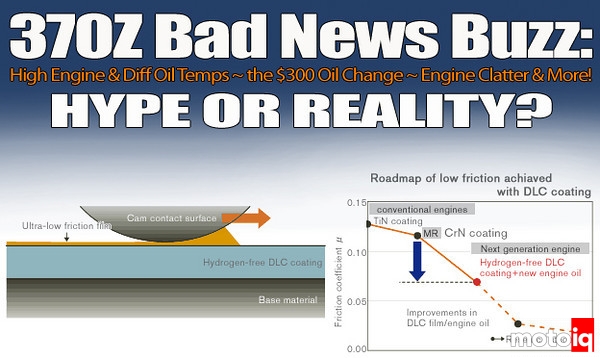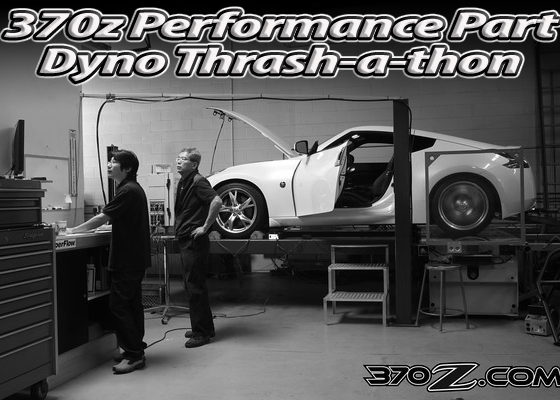,
This leads to the next issue that has arisen with the VQ37VHR. When the engine was first introduced in the G37, there were complaints about a ticking noise coming from the engine, particularly after the first oil change. As common, particularly in these hard economic times, dealerships sometimes offer promotional oil changes at a very low price to help bring customers in the door. Typically these oil changes are a loss leader promotion were the dealerships might actually lose money just to attract customers. Naturally this results in the car getting the cheapest possible oil in the changes. If a G37 had low quality oil put into it, a customer might notice a very slight ticking noise eminating from the engine later. The noise is so slight that it can usually only be noticed when driving with the window open, close to a reflective surface like a hard wall. More G37 customers complain than 370Z customers probably because the G37 has superior NVH (quietness) to the 370Z and an Infinity customer is pickier.
It has been determined that the noise is caused in part by not using the super oil. The VQ37VHR engines VVEL system uses a reciprocating shoe that wipes back and forth across the cam follower instead of rotating like a cam lobe. This wiping action makes it difficult to establish a hydrodynamic film of oil in the interface between the shoe and the cam follower. Low hydrogen DLC coating is used here to both reduce friction, improve wear in this more difficult to keep lubed interface and to attract the super oil.
The super oil’s attraction to the cam followers helps cushion them hydraulically against the slapping action of the VVEL shoe, thus damping out the noise. Nissan’s TSB for the noise involves switching to the ester super oil and reflashing the engines ECU. Nissan has determined the revving the VQ37VHR without load helps contribute to the noise. What the reflash does is if you free rev between 1500-4500 rpm, the engines ECU will slowly return the engine to idle. If you free rev above 4500, the engine will return to a lower speed more aggressively. The noise is harmless and doesn’t affect engine life; just some people find it annoying. We haven’t been able to hear this noise ourselves in a 370Z’s that didn’t have super oil in them so it must be pretty minor, although these Z’s had intake and exhaust systems. Perhaps the best solution if you are bothered by this noise is to turn on your radio!
 |
| This pod with an air scoop located under this long lead press 370Z contains a differential cooler heat exchanger |
The final controversy involves differential coolers. Some of Nissans early production prototypes and long lead press cars were spotted with engine and differential oil coolers. In fact we were one of the first publications to notice this and report about it way before the car was launched. From some of our experience racing 350Z's and 300ZXes, we have noticed that the 350Z runs way higher diff temps than the 300ZX and older cars because the diff is tucked up high in the body structure and doesn't get much air flow exposure.
The 350's raced in SCCA T2 class and Koni Challenge were plagued by diff failure, usually the diff locking up! Diffs would sometimes fail in as little as 30 minutes of continual track use. In these racing classes, particularly T2, the cars are in pretty close to stock condition so it is feasible to think that a street car driven at a track day might experience the same issues.
 |
| The long lead press 370Z has a pick up for the diff cooler pump where the drain plug is normally located |
When working with Steve Mitchell's Time Attack 350Z, we had to continually monitor diff temp with thermal indicator paint, stickers and an IR gun and run carefully as not to exceed 20 minutes or so to avoid diff failure. Eventually Steve went with a diff cooler.
The 370Z is exactly the same in these respects. The 370Z uses the same short nose R200 diff and has the same high out of airflow diff mounting position as the 350Z, and after seeing the cooler on the prototypes, we can assume that the 370 is going to have the same diff temp issues as the 350 did under track conditions. We feel that for sporting street use and short duration motorsports events like autocross, that you will be ok but for track days, avoid doing back to back sessions, use temp labels and an IR gun thermometer to track temp and be careful for track sessions more than 30 minutes long. For racing or any track use with a mechanical LSD, a diff cooler is probably going to be needed. Be wary of temps above 280 degrees. For street or track use a high quality synthetic gear lube, with frequent changes after track use.
GT Motorsports has just introduced a diff cooler kit for the 370Z.
This is a race quality part using a Tilton/Denso oil pump, real AN fittings and plumbing and a Setrab heat exchanger, all top shelf components.
 |
| To move the heavy gear oil to the heat exchanger, the 370Z long lead press car uses this electric driven georotor pump |
Is the 370Z a perfect car? No nothing is. Are these issues major? They can be but they are easily dealt with. Is a 370Z a great performance value and a great overall car? Hell yes, we feel that a 370Z is one of the best bang for the buck vehicles when you consider price, performance, economy and quality. Now perhaps get an oil cooler, add some good engine oil and stop your whining, you still made a great purchase.



